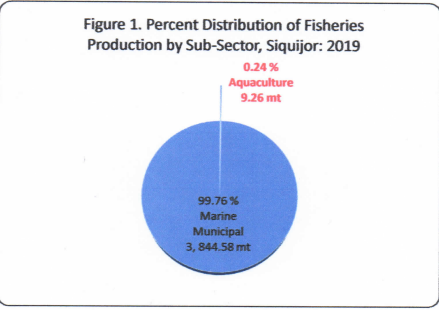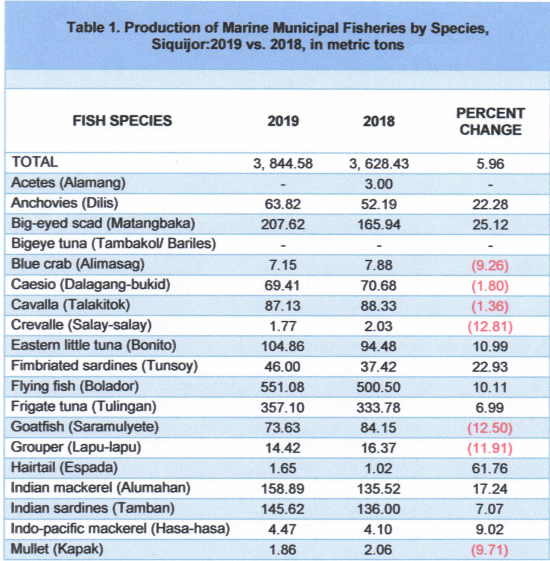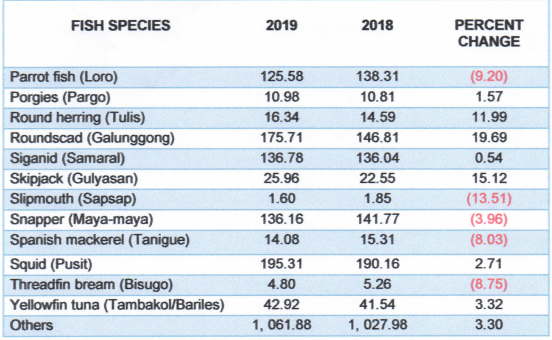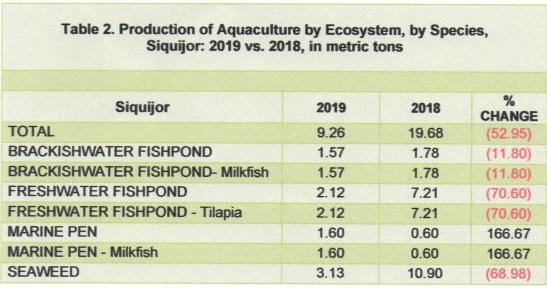Production of fisheries in Siquijor province is contributed by aquaculture and marine, municipal fishing only. Aquaculture covers operations on brackishwater and freshwater fishponds, fishpen, fishcage and seaweeds, while marine municipal fishing covers all fishing operations carried out without the use of boat or the use of a boat of three (3) gross tons or less and all fish catch and other aquatic products are landed and traded in all municipal fish landing centers around the province. In 2019, 99.76 percent of the production was contributed by marine, municipal fisheries, while only 0.24 percent came from aquaculture.

MARINE MUNICIPAL FISHERIES PRODUCTION GROWS UP BY 5.96 PERCENT IN 2019
Production on marine municipal fisheries in Siquijor was up by 5.96 percent in 2019 compared to its record in 2018. Among the top 31 species listed below, flying fish (bolador) had the highest production. It increased from 500.50 metric tons in 2018 to 551.08 metric tons in 2019. It was followed by Frigate tuna (tulingan) with a production record in 2018 of 333.78 and it moved up to 357.10 metric tons in 2019. Other marine species also moved up from 1,027.98 metric tons in 2018 to 1,061.88 metric tons in 2019.


AQUACULTURE PRODUCTION SLIDES DOWN BY 52.95 PERCENT
Production of aquaculture in the province slid down by 52.95 percent in 2019 compared to its level in 2018. Its production deficit was contributed by brackishwater fishpond, freshwater fishpond and seaweeds. Production of milkfish from brackishwater fishpond decreased from 1.78 metric tons in 2018 to 1.57 metric tons in 2019. On the same way, production of tilapia from freshwater fishpond was down by 70.60percent in 2019. Its production in 2018 was 7.21 metric tons while in 2019 was 2.12 metric tons only. Seaweeds also decreased by 68.98 percent from 2018 report of 10.90 metric tons to only 3.13 metric tons in 2019.

Technical Notes:
• The Fisheries Production Survey of the Philippine Statistics Authority (PSA) is divided into four (4) major fisheries surveys. These are the Quarterly Commercial Fisheries Survey (QCFS), Quarterly Municipal Fisheries Survey (QMFS), Quarterly Inland Fisheries Survey (QIFS) and Quarterly Aquaculture Survey (QAqS). The commercial and municipal fisheries surveys aim to provide quarterly data on volume and value of fish production by species, by region and by province. The aquaculture surveys are intended to generate quarterly data on volume and value of cultured species by environment, by type of aquafarm, by region and by province.
• The survey on commercial fisheries production covered 57 provinces and cities. For municipal fisheries and aquaculture surveys 81 provinces and cities were covered.
• The sampling frames for the surveys of commercial and municipal fisheries were established in 2000 through a nationwide listing of landing centers (LCs). Updating of the lists was conducted over the years. The designed used was a two-stage stratified random sampling with the landing centers as the first-stage sampling units and fishing boats as the second stage sampling units. The landing centers were stratified based on volume of fish unloaded. The province was the domain of the survey. Inland municipal fisheries included fishing in inland waters such as lakes, rivers, dams, marshes, swamps, etc. Household engaged in inland fishing was the unit of enumeration. For aquaculture survey, the lists of brackish water fishponds, freshwater fishponds, freshwater fish pens/fish cages, marine fish pens/ fish cages, oyster/mussel and seaweed farms by province served as the sampling frames.
Concepts and Definition:
Aquaculture - fishery operation involving all forms of raising and culturing of fish and other fishery species in marine, brackish and fresh water environment. Examples are fishponds, fish pens, fish cages, mussel, oyster, seaweed farms and hatcheries.
Aquafarm - the farming facilities used in the culture or propagation of aquatic species including fish, mollusk, crustaceans and aquatic plants for purposes of rearing to enhance production.
Brackish water – is a mixture of seawater and freshwater with salinity that varies with the tide. Examples are estuaries, mangroves and mouths of rivers where seawater enters during high tide.
Commercial fishing – is the catching of fish with the use of fishing boats with a capacity of more than three gross tons for trade, business or profit beyond subsistence or sports fishing.
Fisheries - all activities relating to the act or business of fishing, culturing, preserving, processing, marketing, developing, conserving and managing aquatic resources and the fishery areas including the privilege to fish or take aquatic resources thereof (RA 8550).
Fisheries Sector - the sector engaged in the production, growing, harvesting, processing, marketing, developing, conserving and managing of aquatic resources and fishery areas.
Fish Cage - stationary or floating fish enclosure made of synthetic net wire/bamboo screen or other materials set in the form of inverted mosquito net ("happa" type) with or without cover with all sides either tied to poles stacked to the water bottom or with anchored floats for aquaculture purposes.
Fishing Gear - any instrument or device and its accessories utilized in taking fish and other fishery species.
Fishing Grounds - areas in any body of water where fish and other aquatic resources congregate and become target of capture.
Fish Pen - an artificial enclosure constructed within a body of water for culturing fish and fishery/ aquatic resources made up of bamboo poles closely arranged in an enclosure with wooden materials, screen or nylon netting to prevent escape of fish.
Fishpond - a body of water (artificial or natural) where fish and other aquatic products are cultured, raised or cultivated under controlled conditions. This is land-based type of aquafarm. Note that the setting-up of fish cages in ponds does not make the operation of fish cage and at the same time a fishpond.
Freshwater – is water without salt or marine origin, such as generally found in lakes, rivers, canals, dams, reservoirs, paddy fields and swamps.
Landing Center - place where the fish catch and other aquatic products are unloaded and traded.
Inland Municipal Fishing - the catching of fish, crustaceans, mollusks and all other aquatic animals and plants in inland water like lakes, rivers, dams, marshes, etc. using simple gears and fishing boats some of which are non-motorized with a capacity of three gross tons or less; or fishing not requiring the use of fishing boats.
Municipal Fishing - covers fishing operation carried out with or without the use of a boat weighing three gross tons or less.
(SGD.) AURELIA M. CANDA
Chief Statistical Specialist

